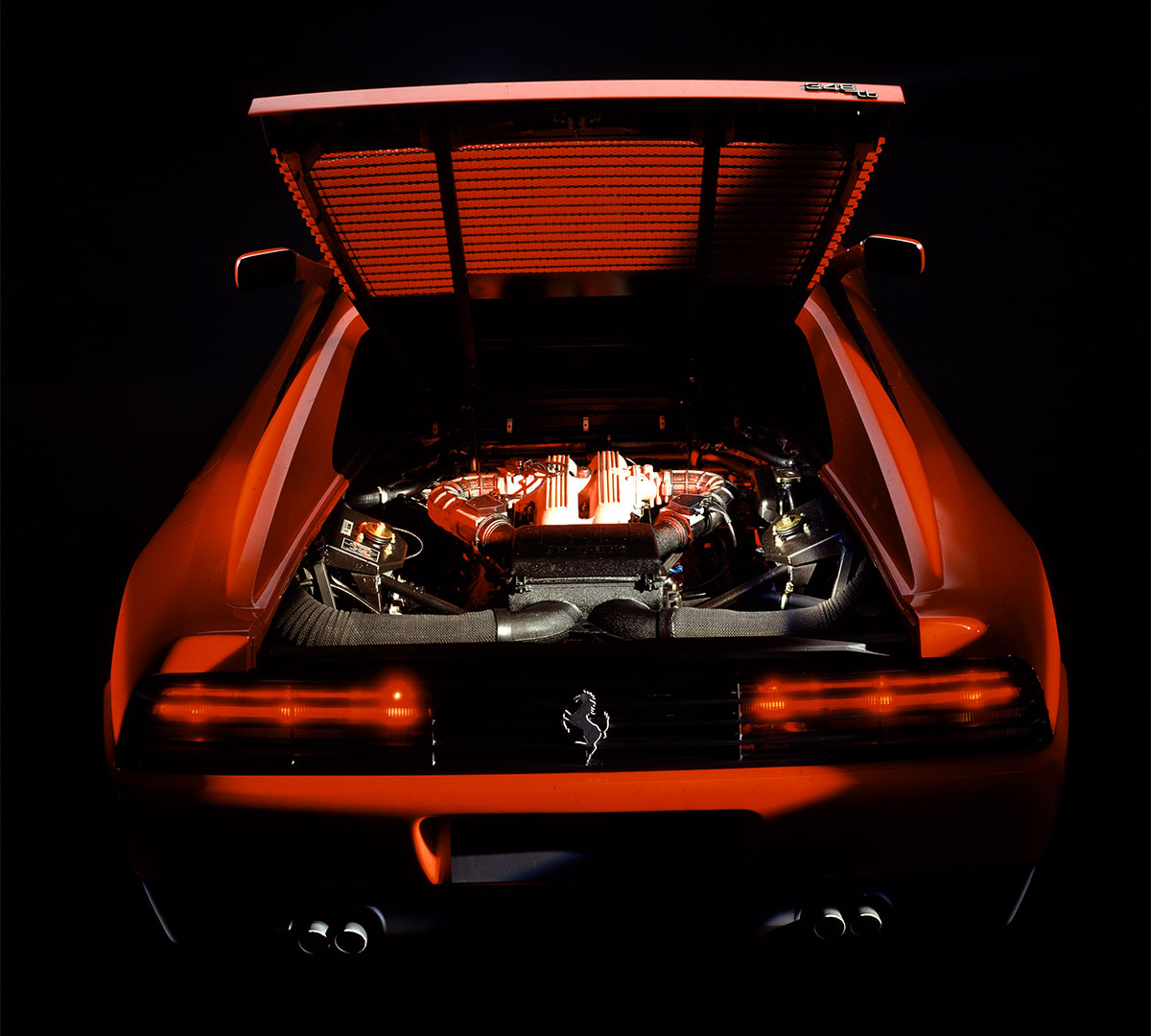?width=1920&height=1600)
Ferrari 348 TB
Heir to the 328 GTB, the 348 TB was actually a completely new car, which offered a new interpretation of the two-seater mid-engined V8 berlinetta. The body combined styling cues from the Testarossa – along the flanks – with ones from classic models of the past (such as the front-end treatment, reminiscent of the 375 MM).

The engine
Mated to a new transverse gearbox, the longitudinally-mounted engine produced 300 bhp (221 kW), which the new, high torsional strength, semi-monocoque chassis transferred to the road extremely efficiently.

In the autumn of 1989 the era of the transverse V8 engined Ferrari range, which had started with the presentation of the Dino 308 GT4 at the Paris Salon in October 1973, reached the end of the road when the 328 series ceased production.
The replacement was the all new 348 model, presented at the 1989 Frankfurt Salon, fitted with a longitudinally mid-mounted V8 engine, initially available in tb (“b” for berlinetta) or ts (“s” for spider, but actually a targa top) form.
The 348 in the model name referred to the 3.4 litre engine capacity and eight cylinders, whilst the “t” in the designation referred to the transverse gearbox mounted at the rear of the engine. This was the first completely new model announced by the company subsequent to the death of Enzo Ferrari in August 1988.

The engine was a twin overhead camshaft per bank, four valves per cylinder, 3.4 litre V8 unit, initially with factory type reference 119D, then 119 G, and finally 119 G040 when fitted with catalytic converters.
It had a total cubic capacity of 3405cc, and a bore and stroke of 85mm x 75mm, with spark plugs between the camshafts, fitted with a Bosch Motronic M2.5 combined fuel injection and ignition system, which was upgraded to the M2.7 version during the production run. At the rear of the mid mounted engine was a transverse five speed plus reverse all synchromesh gearbox and transaxle unit.


Aerodynamic spoke profile
The new model was a radical departure from the design philosophy of its predecessor, not only in the mechanical layout, but also in the style of the body, and the chassis construction. Along with the sister 348 ts model, this was the first series production Ferrari not to have a separate tubular steel chassis frame. Instead it used a pressed steel chassis, with a separate tubular steel engine sub-frame bolted to it, with the body panels robot welded, and bolted, to the main structure. The wheelbase was 100mm more than the 328 model that it succeeded at 2450mm, and the chassis carried factory type reference F 119 AB on the berlinetta.

The body was designed by Pininfarina, and bore a strong family resemblance to the Testarossa model, but on a smaller scale. The similarities are particularly noticeable in the horizontally straked air inlets in the door ducts to the side mounted radiators, and the rear light treatment, where the lenses are hidden behind a full width matt black slatted grille. When the Testarossa was given a facelift in 1992 to become the 512 TR, the new nose treatment used was very similar in style to that of the 348 models, making the likeness even greater. On both models the front “radiator grille” was a dummy inset satin black egg crate pattern unit, to provide the traditional Ferrari face.
The alloy wheels maintained the traditional Ferrari five spoke design, with five bolt fixing, but with an aerodynamic spoke profile unique to this series of models.

The interior featured a pair of leather trimmed seats with manual adjustment, featuring supportive side bolsters, adjustable head restraints and three point inertia reel seat belts. The main instruments were housed in a deep binnacle ahead of the three spoke leather trimmed steering wheel, whilst on the passenger side a glove box was provided in the dash face. Between the seats there was a centre console running into the lower edge of the dashboard, incorporating ancillary instrumentation and switchgear, together with the gear lever in the traditional open gate.
Electrically operated windows and door mirrors were provided, whilst the latter had heating elements, which were actuated by the rear screen demister switch.

In 1993 a Challenge Race Series was inaugurated for the 348 models. In this, clients paid a set fee for a safety/performance kit and track support for the season. This series proved very popular, and evolved into that for the F355 models that succeeded the 348 series. During 1995 both series of cars were allowed to participate during the model changeover period.
The 348 tb model ceased production in 1993 with the announcement of the updated 348 GTB, during the production period 2894 examples were produced in the chassis number range 81617 to 96679.

- V8ENGINE
- 3404.70 ccTOTAL DISPLACEMENT
- 221 kWMAXIMUM POWER @ 7200 rpm
- over 275 km/hTOP SPEED
- Typerear, longitudinal 90° V8
- Bore/stroke85 x 75mm
- Unitary displacement425.59cc
- Total displacement3404.70cc
- Compression ratio10.4 : 1
- Maximum power221 kW (300 hp) at 7200 rpm
- Power per litre88hp/l
- Maximum torque324 Nm (33 kgm) at 4200 rpm
- Valve actuationtwin overhead camshafts per bank, four valves per cylinder
- Fuel feedBosch Motronic electronic injection
- IgnitionBosch static electronic, single spark plug per cylinder
- Lubricationdry sump
- Clutchtwin-plate
- Framesteel monococque with tubular steel rear sub-frame
- Front suspensionindependent, unequal-length wishbones, coil springs over gas-filled telescopic shock absorbers, anti-roll bar
- Rear suspensioniindependent, unequal-length wishbones, coil springs over gas-filled telescopic shock absorbers, anti-roll bar
- Brakesdiscs
- Transmission5-speed + reverse
- Steeringrack-and-pinion
- Fuel tankcapacity 95litres
- Front tyres215/50 ZR 17
- Rear tyres255/50 ZR 17
- Typetwo-seater berlinetta
- Length4230mm
- Width1894mm
- Height1170mm
- Wheelbase2450mm
- Front track1502mm
- Rear track1578mm
- Weight1393kg (dry)
- Top speedover 275km/h
- Acceleration 0-100 km/h5.6sec
- 0-400 m-
- 0-1000 m24.7sec
- engine
- design
- Technical Details
- Media gallery